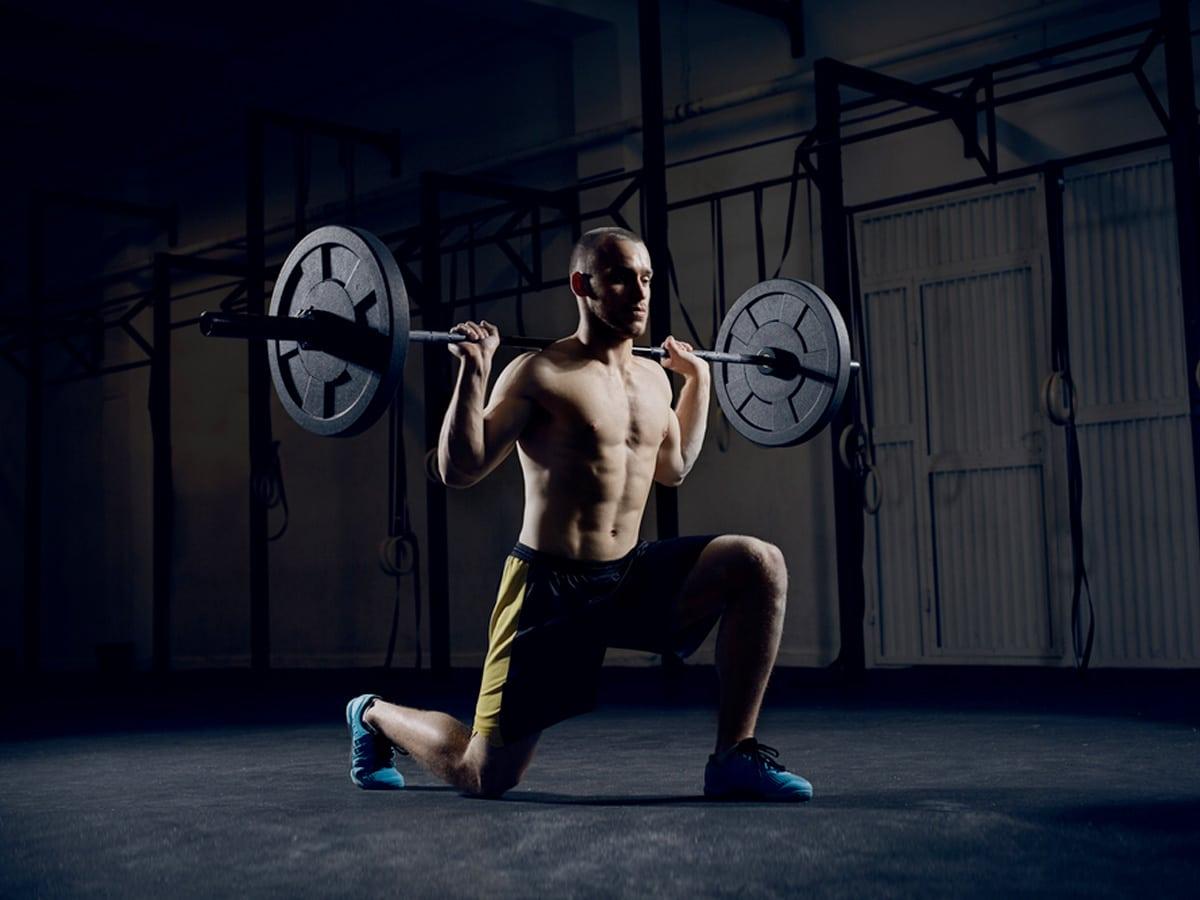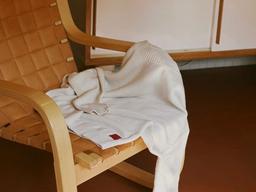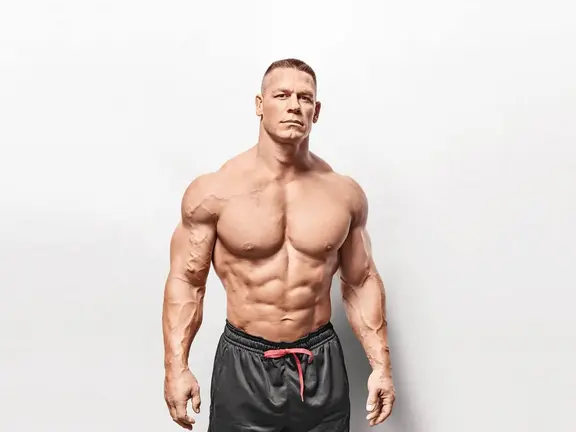Training your muscles has become an art, with men frothing over that time of day they can finally hit the gym to continue crafting their bodies. Regularly exercising the usuals: back, chest, calves, arms, abs, shoulders, and leg muscles, every week — and at times, doubly. And apart from the slew of muscles that are trained ad nauseam are a smattering of body parts that have been scratched off the workout menu. Take the forearms, for instance. Or, in this case, the glutes.
Call ’em the butt, bum, or even arse, the glutes are an integral part of the human body and should be treated as such; helping in the extension, abduction, and rotation of one’s hips (1). These muscles assist in stabilising the upper body, aiding movement, and extending the hip to enable physical activity (2). But beyond the study of anatomy lies a much more fascinating (and funny) reason why men should dedicate more time to working out their behind.
It turns out, a recent study by Men’s Health found that chicks dig dudes with a round rear (way to go at flipping the script on that one, Science). Our point is, the glutes should be routinely exercised from a strength and aesthetic standpoint. And when you put your arse into it, you’ll even start to see your abs, leg, and lower back muscles develop (3).
Best Glute Exercises for Men
So if your current glute exercise routine needs a kick in the butt, you’d be hard-pressed to find a more medically reviewed, expertly curated, and detailed exercise plan for your glutes (or any other body part) that not only focuses on the hypertrophy of your muscles but on bolstering their strength via eccentric training. Whether you need to learn a few new moves or sharpen up on techniques, the following are some intensity-amplifying workouts that can be done at home, the gym, with or without equipment to bring out bigger and stronger glutes.
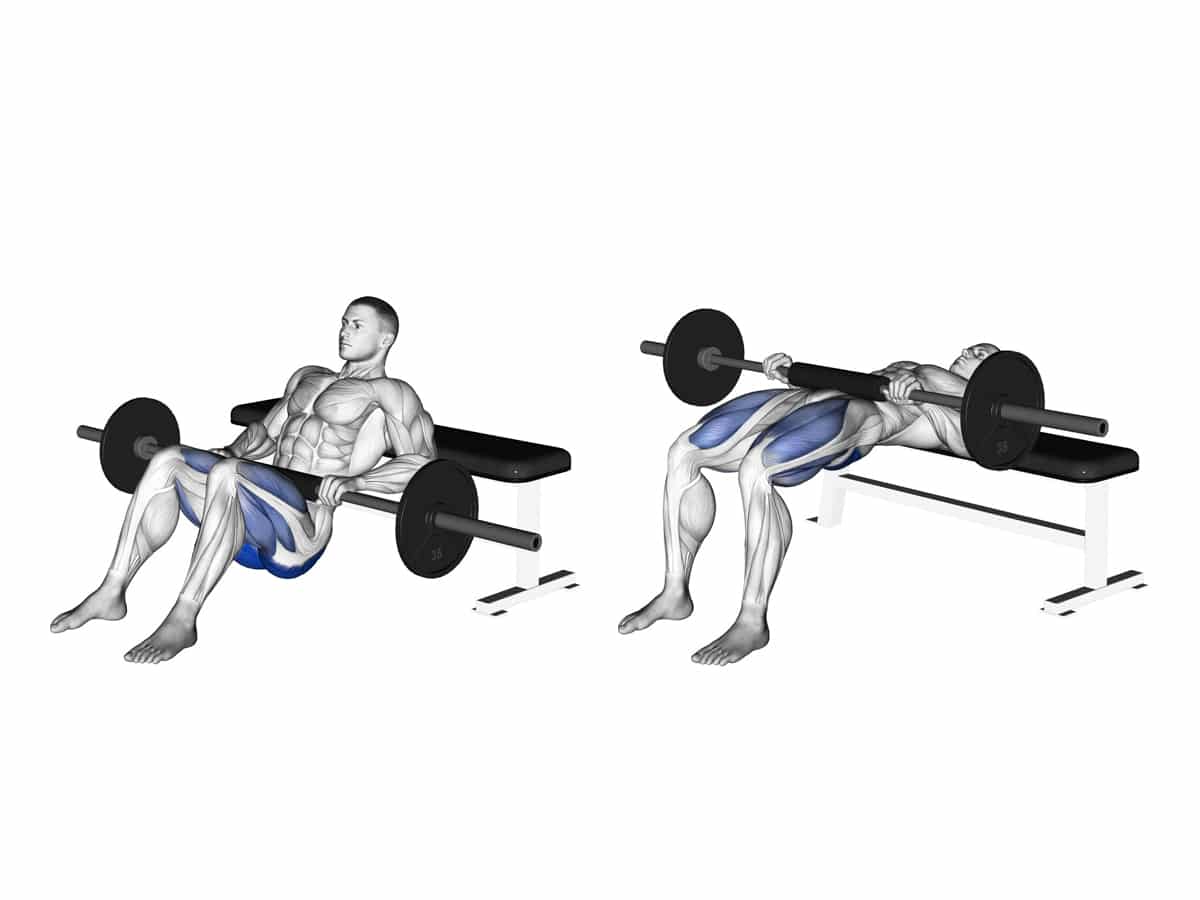
1. Barbell Hip Thrust
The barbell hip thrust is one of the most effective exercises on our list for your glutes. Performed regularly by bodybuilders, celebrities, and sprinters in workout sessions, this hip training exercise is a thrust motion that targets the glutes — chiefly the gluteus medius and gluteus maximus — as well as the hamstrings. And although it seems quite straightforward, the thrust also workouts your quads, core, and hip adductors. Routinely practising the barbell hip thrust strengthens and conditions the knee, lower back, and hips; enhances one’s athleticism; and brings out a nicely lifted and round backside (14).
- Start off with your bottom positioned firmly on the ground, your upper back on the bench, and the bar positioned on your hips.
- Now, grip the bar at the far side of the weights, push through your heels, and lift the barbell with your hips.
- Once the barbell is fully lifted, hold it for a second or two, then steadily lower it back to the starting position.
- Repeat until the set is completed, then increase the weight with each set.
- And if you want to up the ante or make it an isolation exercise, perform it with a single leg.
Reps: 8-10
Sets: 3
Rest: 60 seconds between each set
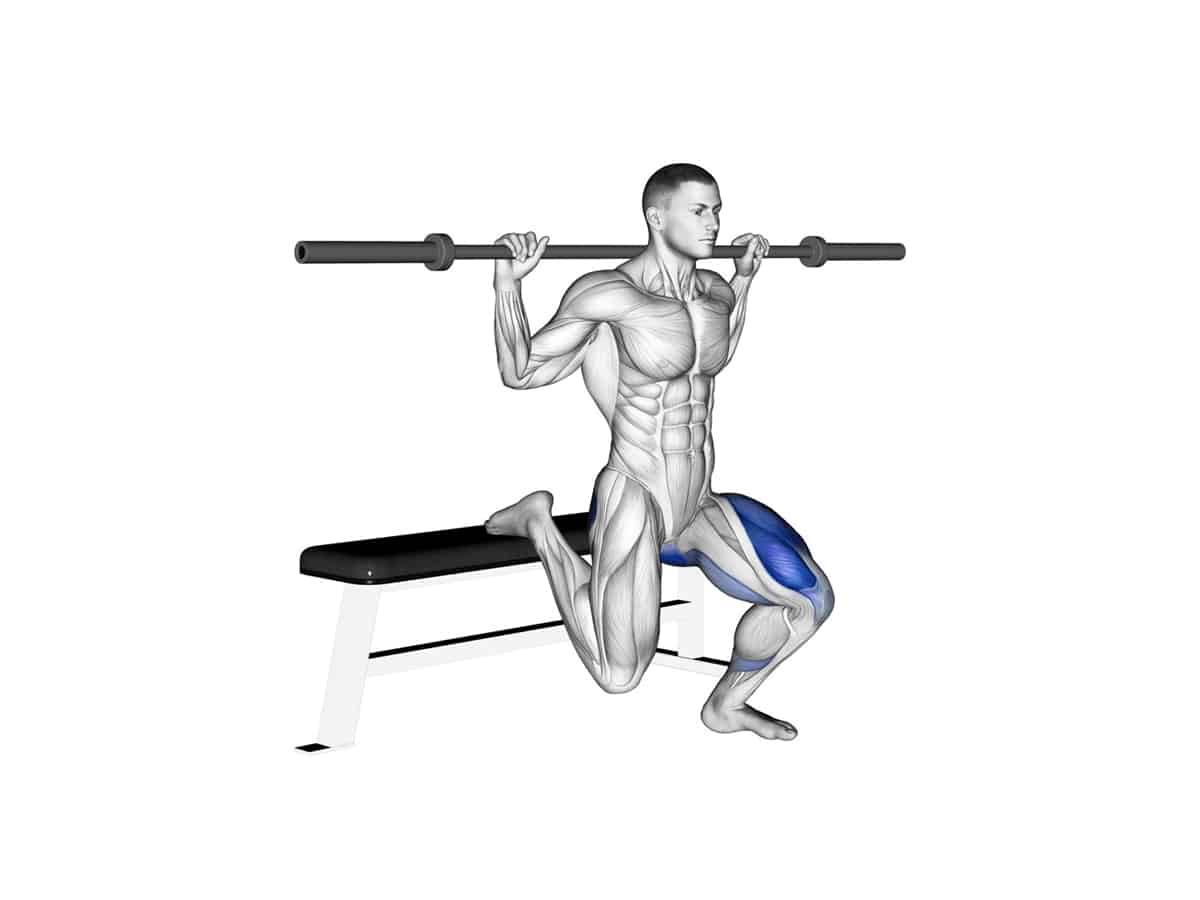
2. Bulgarian Split Squat
Much like a regular squat — but with better workout efficacy — the Bulgarian split squat makes the regular squat exercise look like trash. As one of the many variations of the single-leg squat that works wonders for the lower body, this unilateral exercise targets the same muscles as the traditional squat, but with greater emphasis on the glutes and quads (15). It’s regarded as the star of single-leg exercises for its ability to build control, balance, power, and strength in one’s lower body muscles. One may choose to incorporate weights when performing it.
- Begin by standing in front of a knee-high platform.
- Extend one leg behind you and rest your toes on the bench.
- Keeping your torso upright, slowly lower your right knee toward the floor.
- Remember to keep your front knee at a 90-degree angle.
- Maintain an evenly distributed weight in your whole foot and be sure not to push forward on the toes nor push through the heel.
- Reverse the move and return to the starting position.
Reps: 8-10
Sets: 3
Rest: 60 seconds between each set
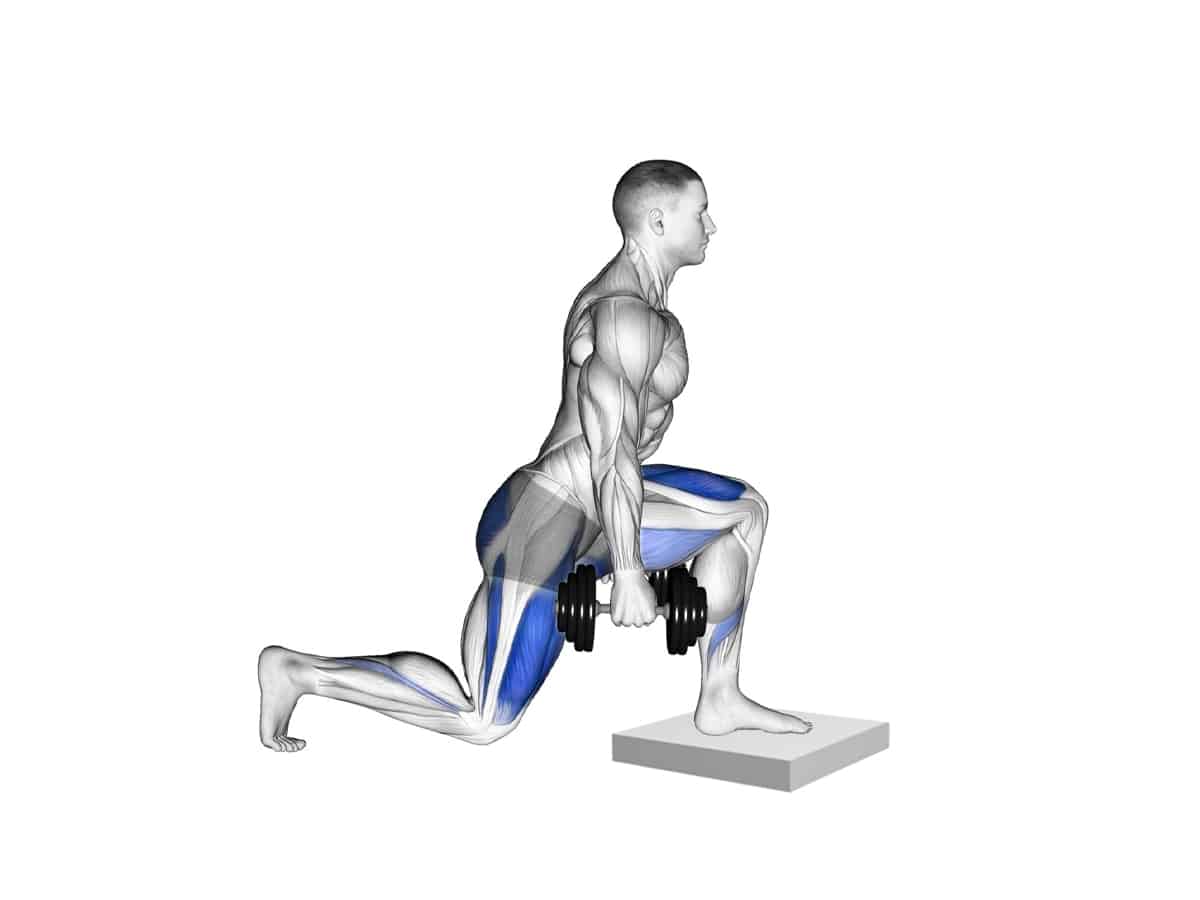
3. Dumbbell Deficit Reverse Lunges
For an exercise that’s been performed monotonously for almost every sports training session, the dumbbell deficit reverse lunge goes one better than its jaded predecessor. Working out the quads, glute, hamstring, and calf muscles, the exercise requires a significant sum of stability to control the movement. The exercise also forces you to balance yourself on one leg at a time, making you feel stronger in your other workouts because it improves your balance all while working out your quads and glutes.
- Start with both feet up on the platform.
- Lift one foot off the platform, stepping back behind you into a rear lunge.
- Allow your back knee to come close to the floor.
- Squeeze your glutes and drive at the top.
- Repeat at a controlled and slow pace.
Reps: 10-15
Sets: 3
Rest: 60 seconds between each set
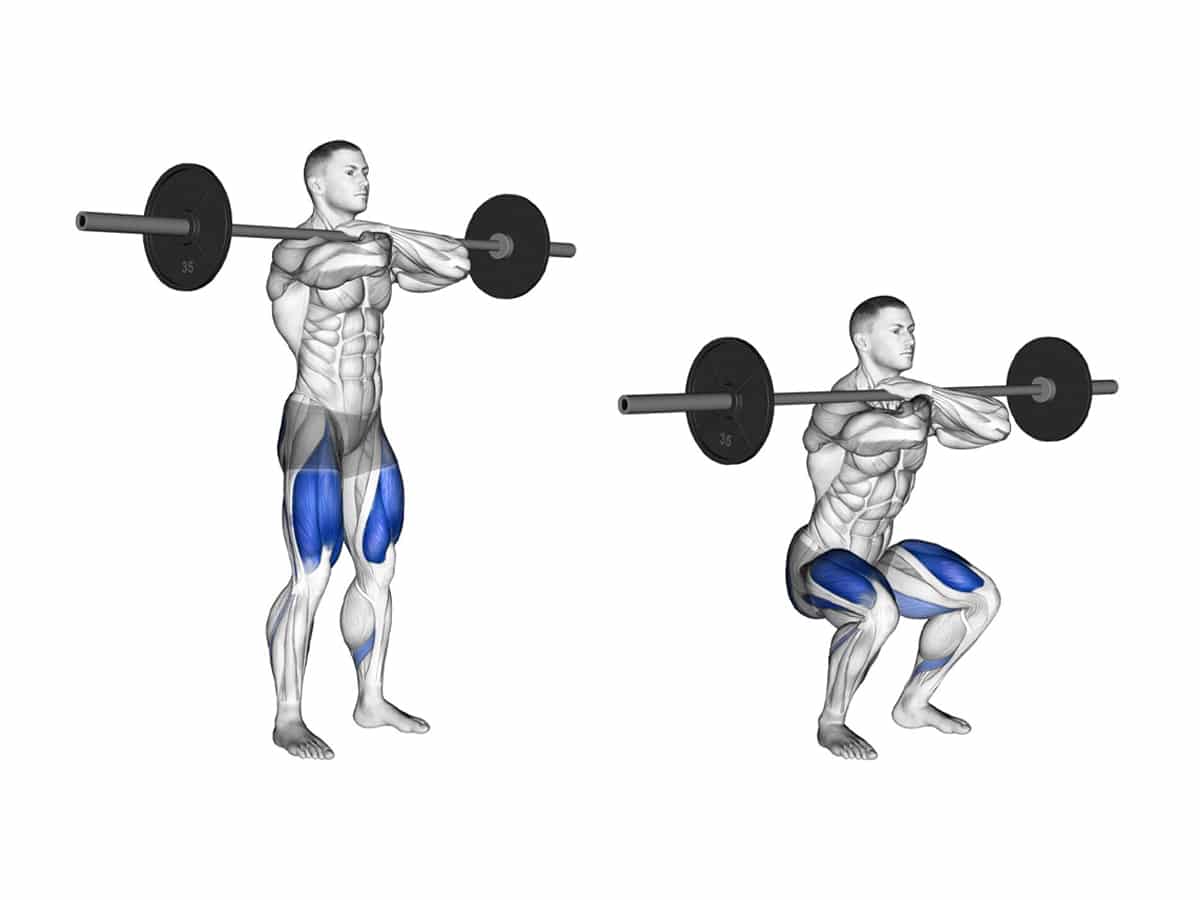
4. Front Squat
The front squat needs no introduction. A common lower-body exercise that — like the string of glute exercises on this listicle — will strengthen your legs and hips, particularly your quads and butt muscles. And much like back squats, front squats are similar, however, the barbell is placed across the front side of your shoulders instead of your upper back.
- To begin, stand with feet shoulder-width apart.
- Send your hips back and down, bending your knees to lower into a squat.
- Keep in mind that your front knee should not protrude past your toes when squatting.
- Keep your chest lifted.
- Drive your feet into the ground to stand back up and remember to exhale.
- Repeat and increase the weight with each set.
Reps: 8-10
Sets: 2-3
Rest: 60 seconds between each set
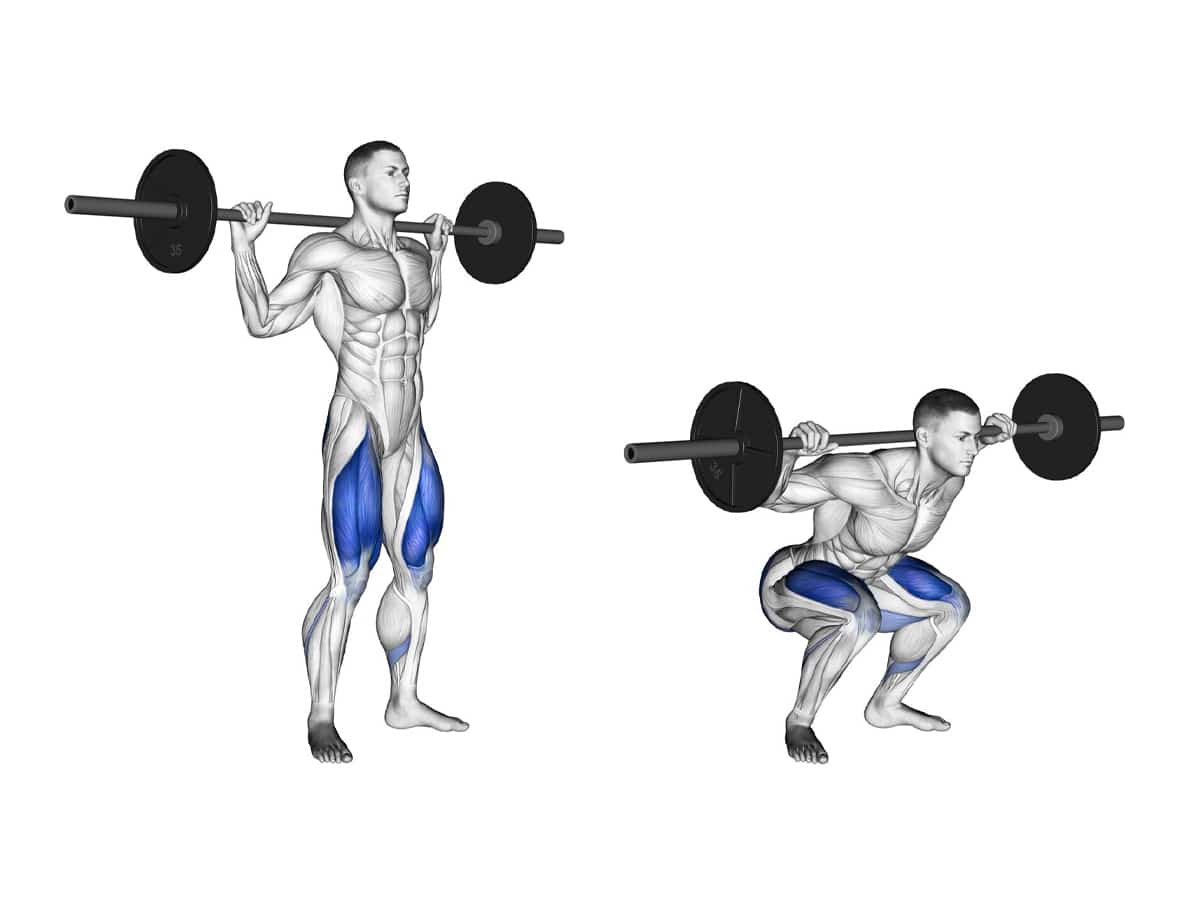
5. Back Squat
Back squatting is a simple strengthening exercise that’ll enhance your athletic performance. Since the exercise necessitates the interaction of many muscle groups, performing it will support better athletic movements such as jumping, running, and lifting (16). But unlike the front squat — which works out your quadriceps and upper back — the back squat will train more of the glutes and hamstrings in conjunction with your quads. Performing this exercise will, in turn, develop stronger lower back muscles and build a more stable core.
- Stand upright with the bar on your upper back and your feet shoulder-width apart.
- Squat down by pushing your knees to the side while moving your hips back.
- Keeping in mind that your front knee should (almost never) protrude past your toes when squatting.
- Squat down until your hips are lower than your knees.
- Squat back up while keeping your knees out and chest up while exhaling.
- Repeat and increase the weight with each set.
Reps: 8-10
Sets: 2-3
Rest: 60 seconds between each set
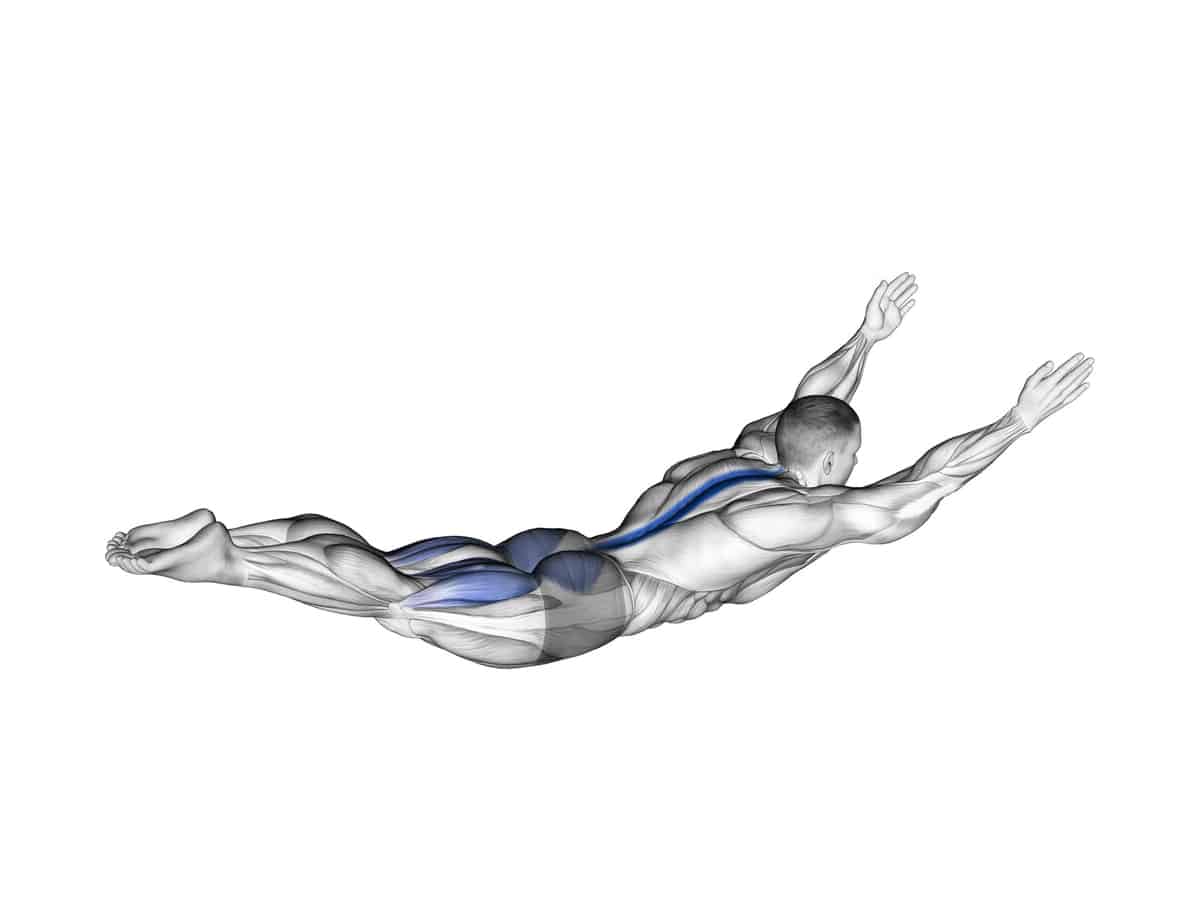
6. Figurehead
Unsurprisingly, figureheads have been the black sheep of body exercises forever. And although the cousin of the front plank exercise may be punishing, it promises a great workout for your lower back muscles, glutes, hamstrings, and abs. Also known as the Superman exercise, figureheads are an excellent military-esque exercise for people of all fitness levels. It addedly complements other core exercises — such as leg raises and sit ups — that mostly focus on the abdominal muscles in the front of your body.
- To start off, lie face down on a mat with your arms by your side.
- Squeeze your glutes and lift your upper body and legs off the ground while lifting your legs so that only your hips touch the floor.
- Hold the position for two to three seconds.
- Slowly return to your starting position.
- Note: avoid lifting your head or hyperextending your neck, which can lead to pain or injury.
Reps: 10-12
Sets: 3
Rest: 60 seconds between each set
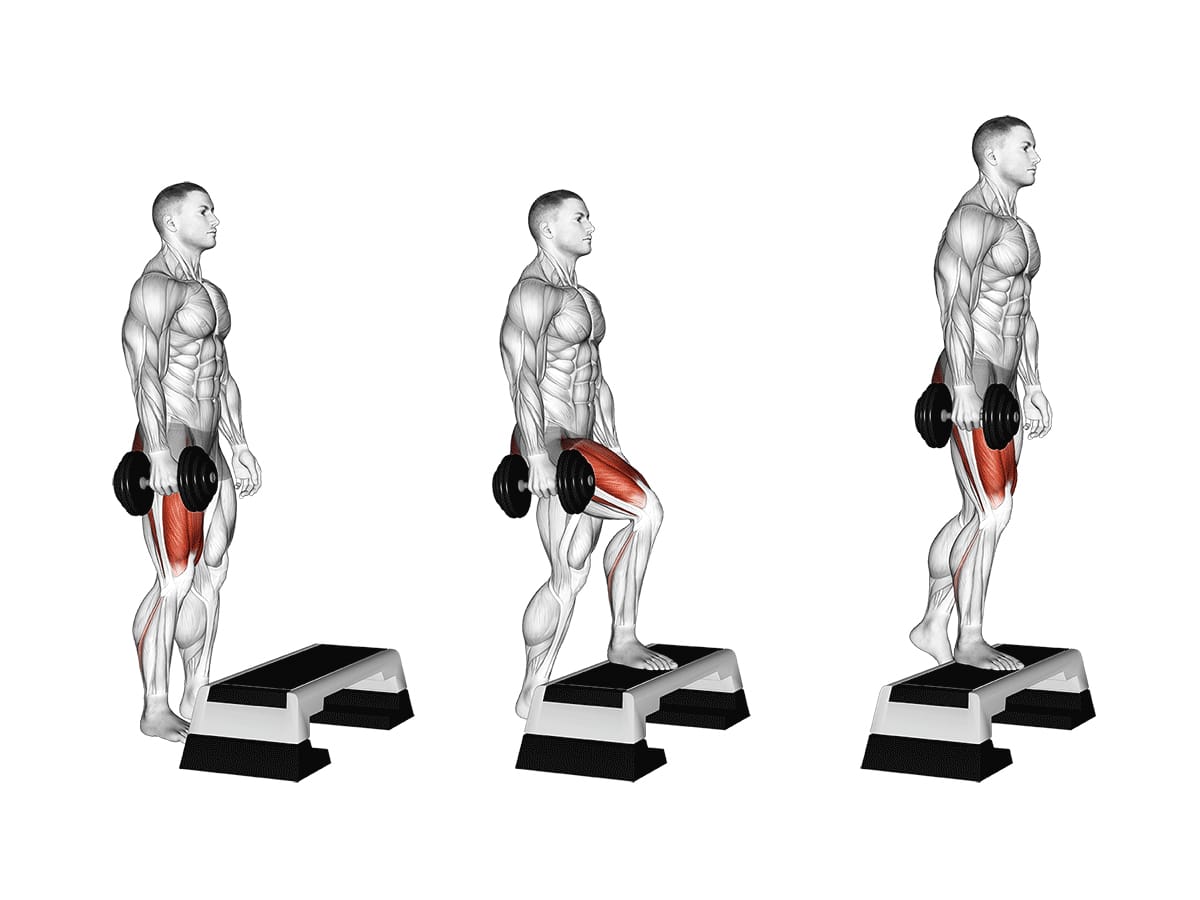
7. Single Leg Step-Ups
Probably the simplest glute exercise ever. The single-leg step-up requires little effort but works wonders for the lower body. On paper, the exercise helps build unilateral lower body strength; targeting the quads, hamstrings, and glute muscles. Now, you can cheat your way through the ease of the exercise, but in the end, you’ll be cheating yourself. So, to properly work out your glutes, consider the following variations to the exercise; a) a higher step, b) incorporating dumbbells, c) pausing and squeezing when atop the step followed by slowly reversing to starting position (which is called eccentric training, and it’s an incredibly effective method of strengthening your muscles) (17). Don’t believe us? Give eccentric training a stab in any training exercise and you’ll see a significant improvement in your muscle strength.
- As with almost every leg exercise, stand with your feet shoulder-width apart.
- Place one leg firmly onto the step and ensure that your knee does not protrude past your foot.
- Drive up with one foot, remembering to let the leg on the box do the work, and keep your torso upright.
- Straighten your leg while engaging your core and bring yourself to standing on the step.
- While keeping your torso and head up, lower your leg down slowly to the ground.
- Repeat with any of the aforementioned variations.
Reps: 8-10
Sets: 3
Rest: 60 seconds between each set
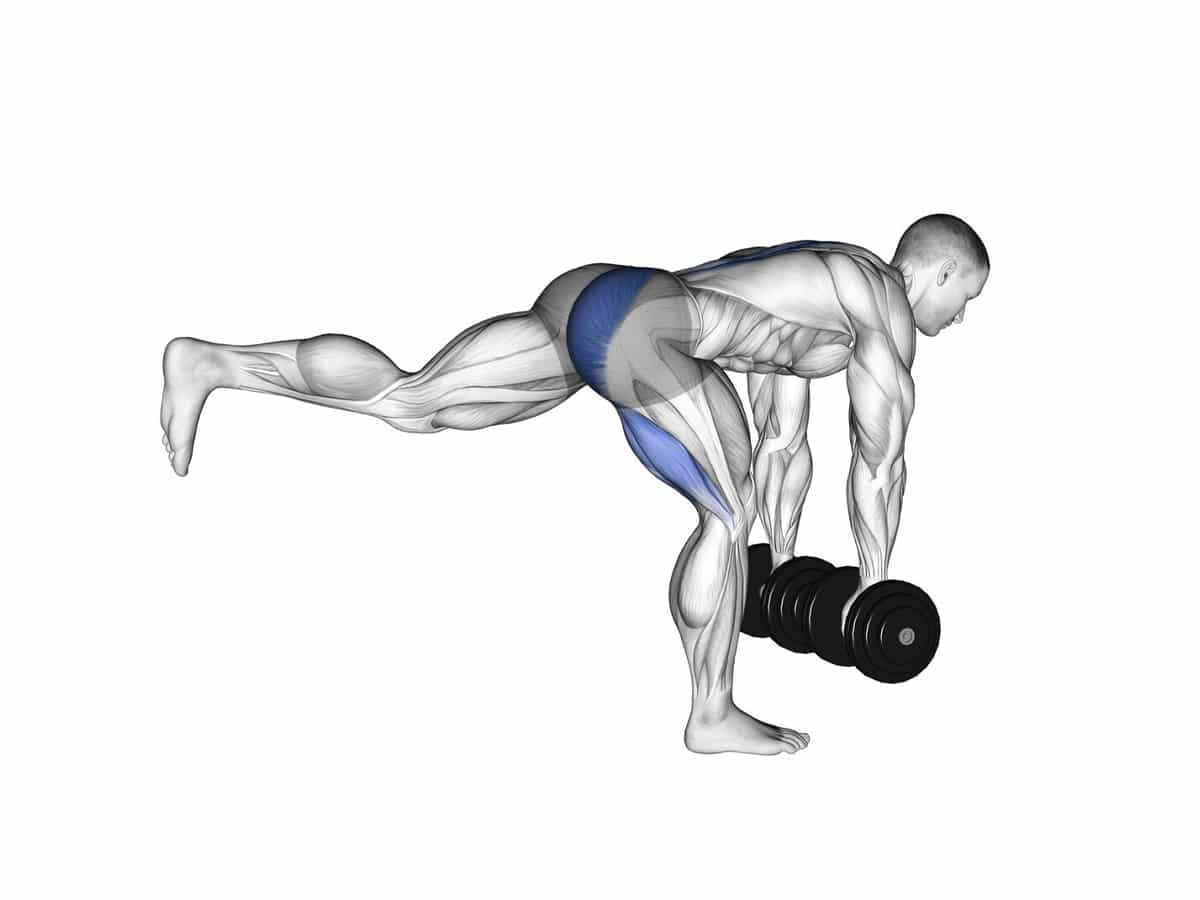
8. Single-Leg Romanian Deadlift
Don’t be fooled by the awkwardness of performing the single-leg Romanian deadlift in the gym. Because once you get past its quirky movement pattern, you’ll learn that this unique deadlift is an all-encompassing exercise. Chiefly targeting the hip, hamstring, and glutes muscles, the single-leg Romanian deadlift is ideal for anyone looking to enhance their running and jumping performance, as well as get a more defined lower body. And though the movement pattern of the exercise may appear simple to the layman, it’s a multi-faceted glute training exercise; activating the core, necessitating hip stability, engaging the upper back, and requiring balance to execute correctly.
- Stand with your feet shoulder-width apart and knees slightly bent.
- Raise one leg off the floor and prepare to swing down in motion.
- Without changing the bend in your knee, keep your back naturally arched, and lower your torso until horizontal to the ground.
- Pause for two seconds when in this position for added strength effect.
- Finally, squeeze your glutes, push your hips forward, and raise your torso back to starting position.
Reps: 8-10
Sets: 3
Rest: 60 seconds between each set
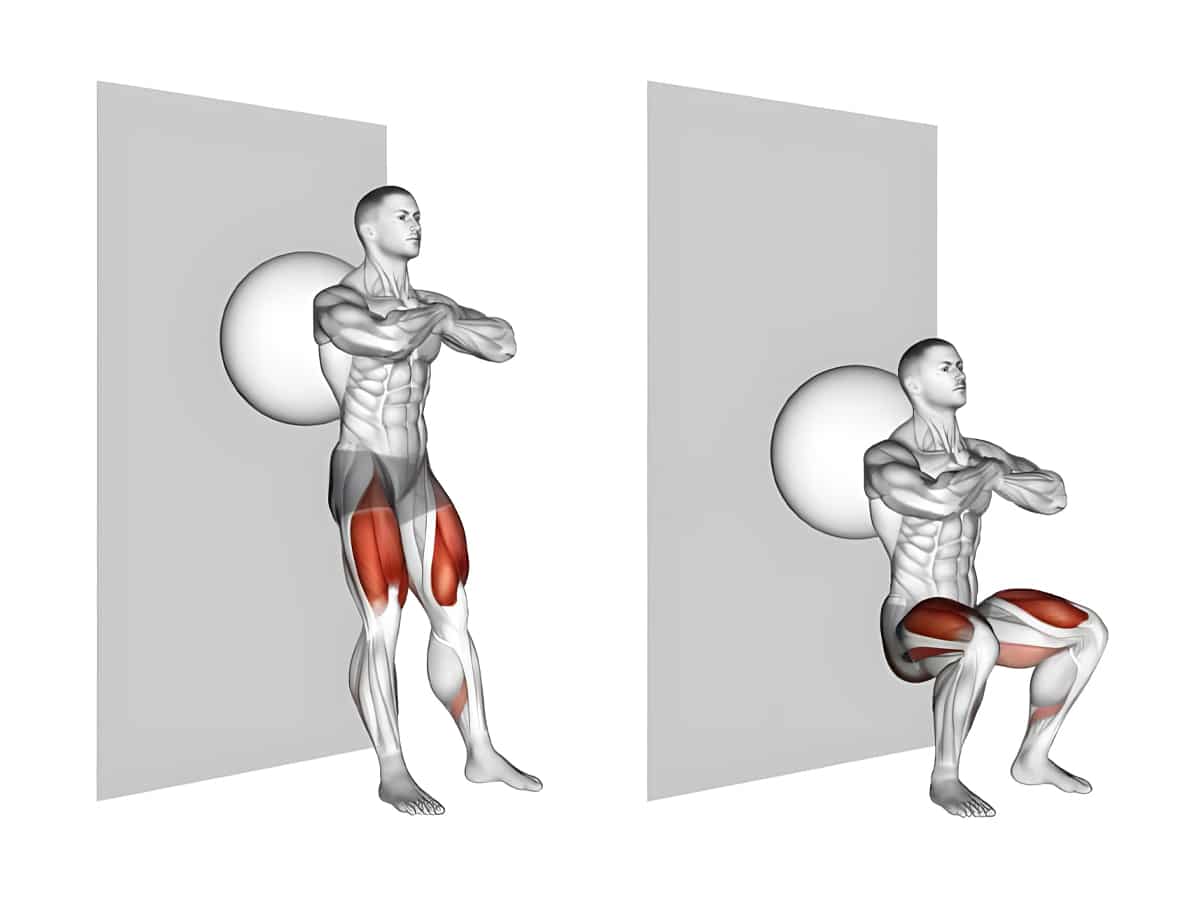
9. Swiss Ball Wall Squat
The Swiss ball wall squat is a fairly L.E (low-effort) exercise. It’s a basic squat but with a Swiss ball sandwiched between your back and the wall. Nothing schmancy. But what makes this exercise more effective than it seems is it demands balance, core stability, a bit of eccentric training, and — as The Rock put it — a little focus. It’s suitable for gymgoers of mature age, folks who’ve just gotten started training, and athletes that need a light workout for recovery. The Swiss ball wall squat is among the scattering of glute exercises one can practise for warm-up and warm-down in a training session to bring out better lower body and core strength.
- Stand with the Swiss ball behind your back, pressing up against a wall with your feet shoulder-width apart.
- Be sure that your feet are positioned more forward than they would be when performing a regular squat.
- Hold your arms out for balance and squat down while keeping your heels flat and knees out.
- Allow the Swiss ball to roll up and down your back when squatting all while keeping your heels firmly on the ground.
- Squat up to starting position and repeat.
Reps: 10-15
Sets: 2-3
Rest: 60 seconds between each set
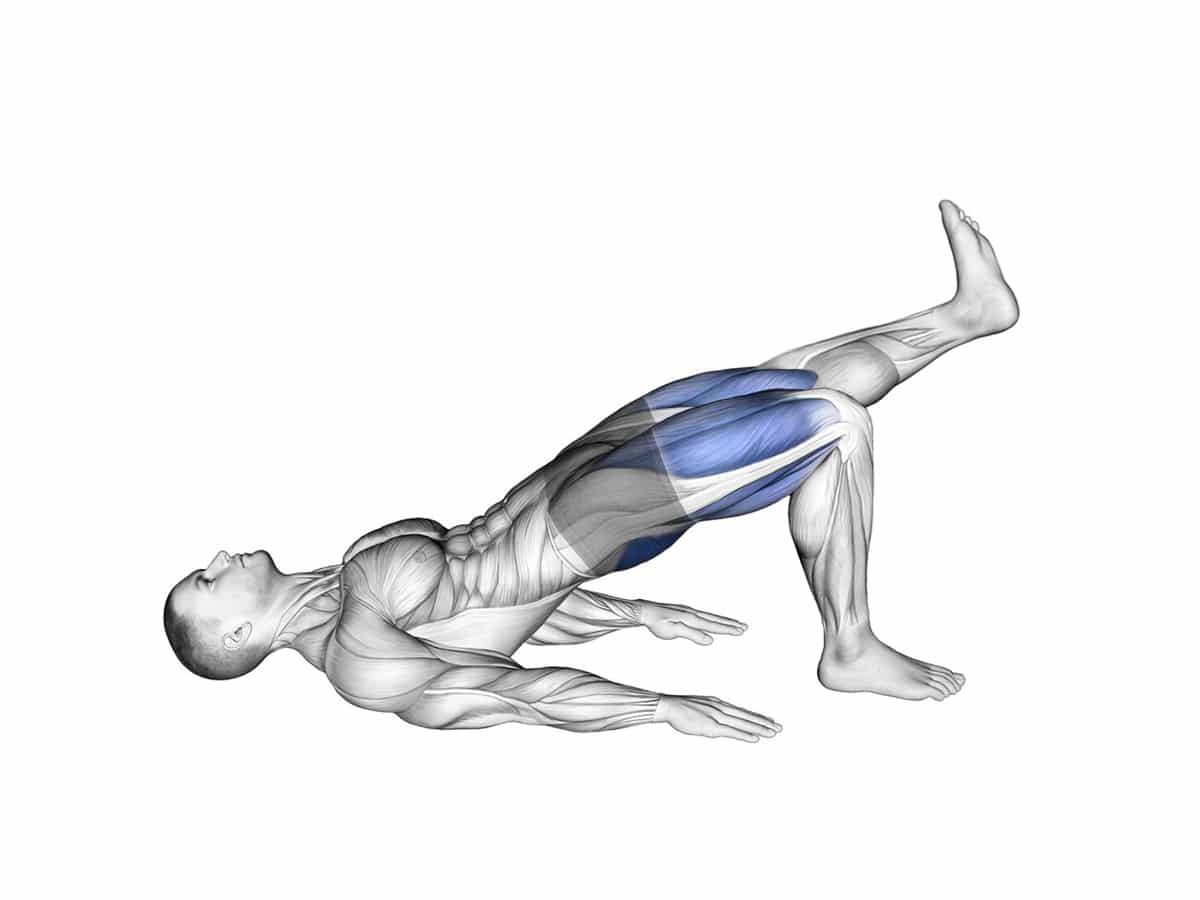
10. Single-Leg Glute Bridge
No glute workout is complete without the single-leg glute bridge. Albeit hard to perform, it’s the most rewarding exercise on our list that rigorously trains the glutes and hamstrings. Usually performed by the common gymgoer and athletes seeking to build more power and strength in the lower-back compartment, the single-leg glute bridge presents two unique forms of training: hypertrophy and eccentric. So, to milk this exercise, you can start off by explosively pushing up off the floor with one leg, then very slowly lowering back to starting position for the added strength effect.
- Lie down on your back with your hands by your sides, knees bent, and feet flat on the floor.
- Lift one foot, extending it almost vertically off the floor at a 45-degree angle.
- Push off the floor with the other foot by raising your hips and tightening your core and glute muscles.
- Be sure to engage your core while in this position.
- Hold for two to three seconds.
- Lower your hips to the floor slowly keeping one leg extended, to return to the starting position.
- Once you’ve completed the reps, switch legs and do it again to complete the first set (because one set is exercising both legs).
Reps: 15-20
Sets: 3
Rest: 60-120 seconds between each set
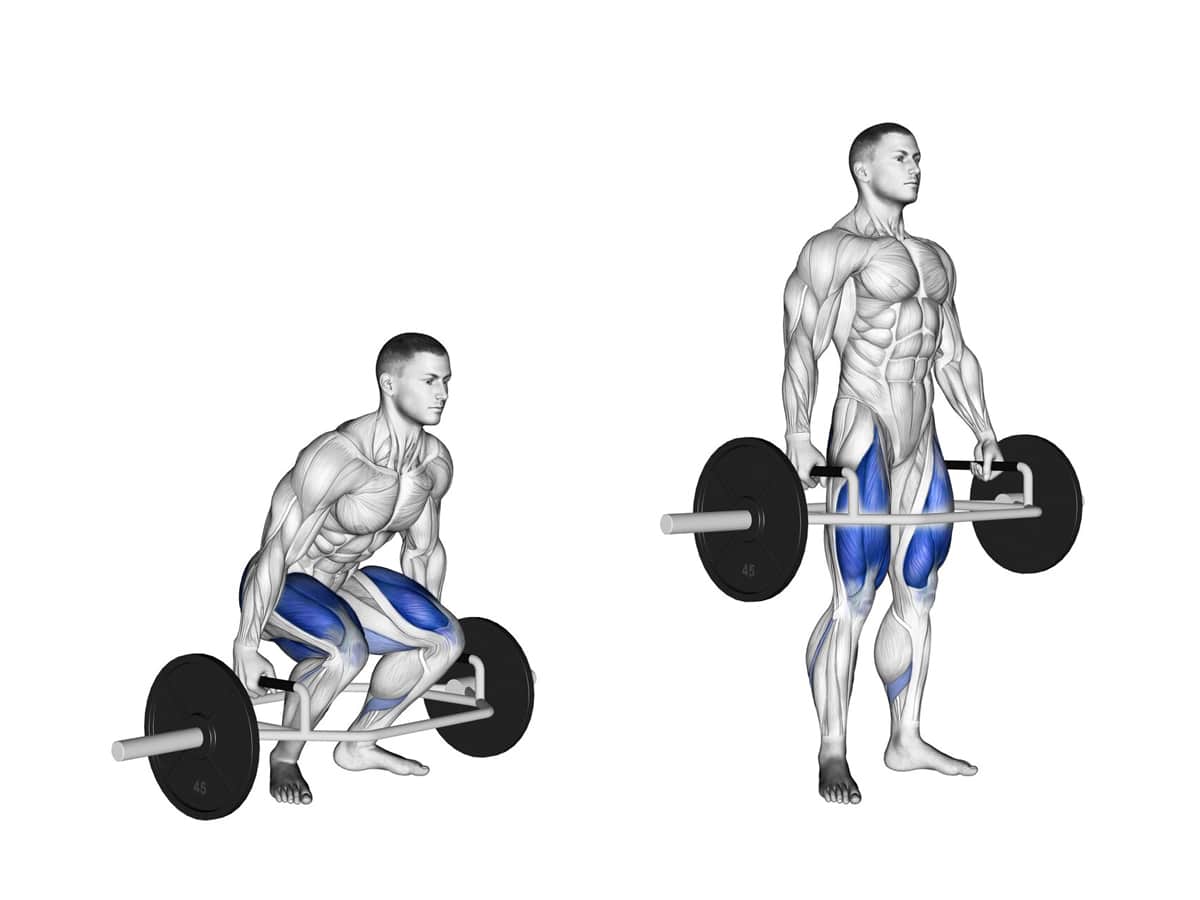
11. Trap Bar Deadlift
If you’re wondering what’s the difference between the trap bar deadlift and the regular deadlift, it’s mostly the bar. The trap bar is hexagonal-shaped. And to perform this type of deadlift, you’ll need to stand in the middle of the hexagon-shaped bar, rather than behind the traditional straight one. Unlike the deadlift, the trap bar deadlift presents a more comprehensive lower-body workout (particularly for quads; but also trains the glutes and hamstrings) and places less stress on the lower back. Many UFC fighters and athletes opt for the trap bar deadlift for its almost “stress-free” component. Why? It takes a heck load of back pain out of the equation and is as close to the classic deadlift exercise as you can get, sans the injuries.
- Stand inside the trap bar, with your feet shoulder-width apart, and shins aligned with the centre of the bar.
- Get into the deadlift position by pushing your glutes down and bending your knees.
- Grip the bar at both ends firmly and look straight ahead.
- With your hips lower than your shoulders, squeeze your shoulders and start to lift.
- Push your feet through the floor to stand straight up, squeezing your glutes at the top once standing.
- Try to slowly lower the trap bar down into the start position. Repeat.
Reps: 6-10
Sets: 2-3
Rest: 60 seconds between each set
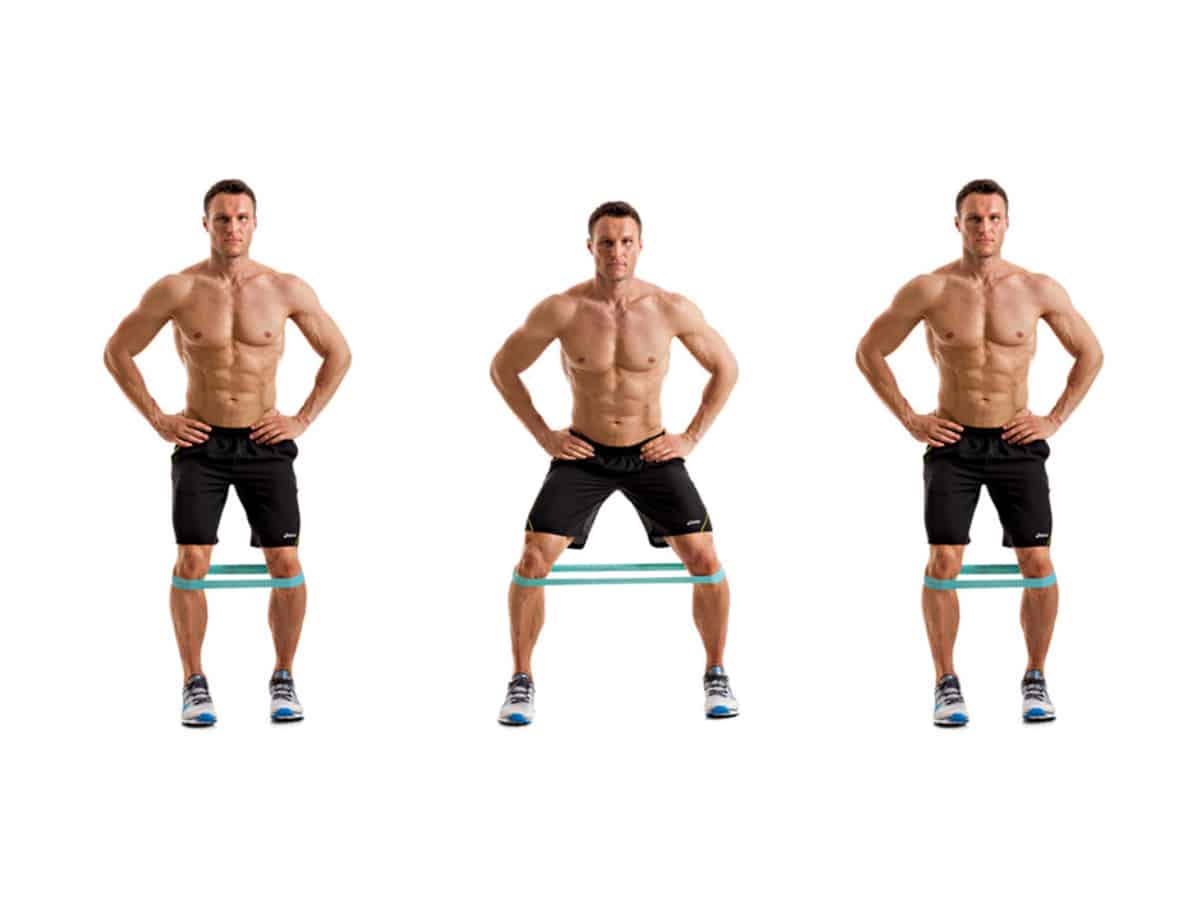
12. Lateral Band Walk
While usually performed for a warmup routine, lateral band walks engage many of the deep muscles that stabilise the pelvis (18). They’re an excellent method of getting your leg and glute muscles (particularly the medius) into definition all while not exerting yourself too much. The exercise involves the use of bands to create resistance and improve hip stability, strengthen the hip abductors — particularly the gluteus medius — and can enhance hip, foot, ankle, and knee stability (19). This, in turn, improves lower body mechanics and prevents injury.
- Place the resistance band above your knees and stand with your feet hip-width apart.
- Squat down to a semi-squat and take a step to the left.
- Keep taking steps to the left and then repeat the exercise steps on the right side.
- Repeat in 15 to 20 repetitions for each leg.
- Too easy? Try wrapping on another resistant band to give your glutes a run for their money.
Reps: 15-20
Sets: 3
Rest: 60 seconds between each set
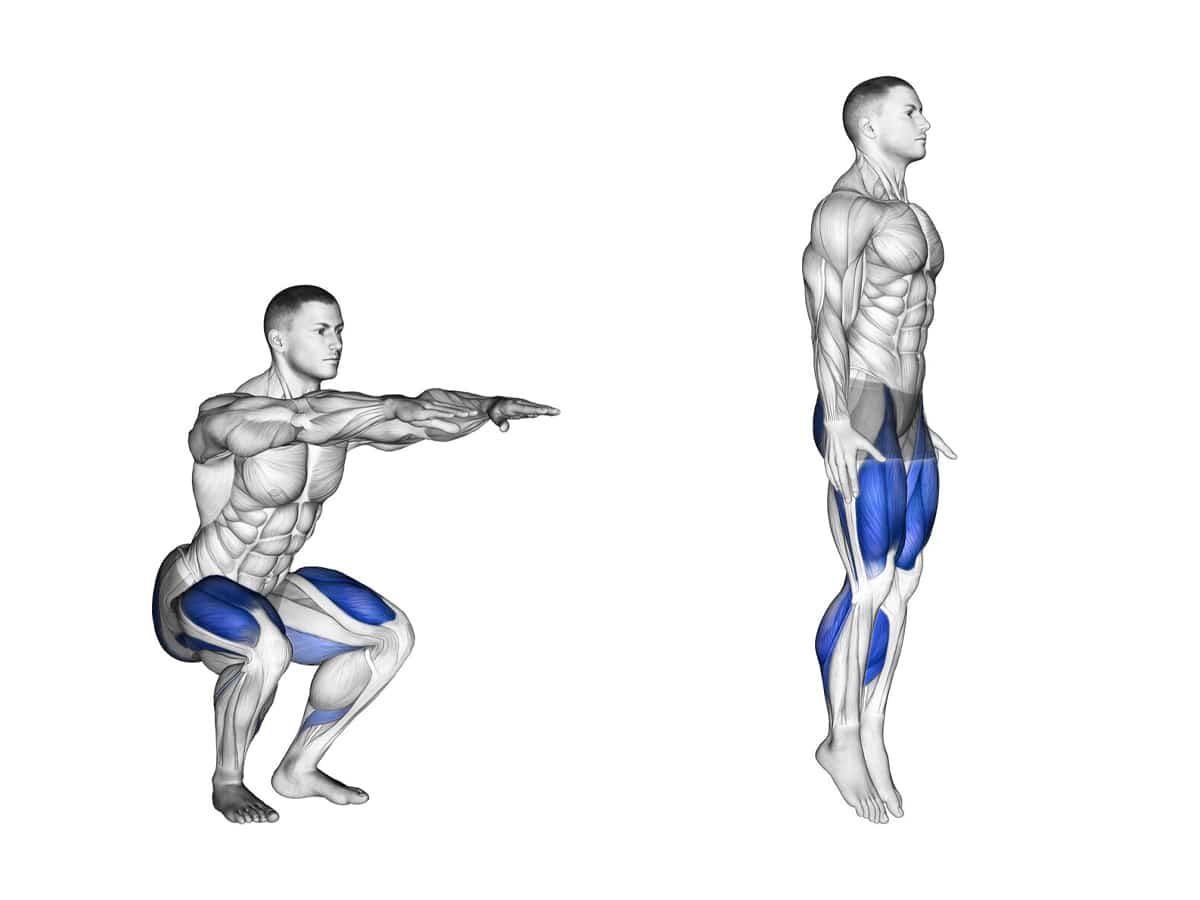
13. Jump Squat
The jump squat is a superb glute exercise for folks looking to build explosive strength in lower body muscles. The exercise focuses on developing the glutes, quadriceps, calf, and lower back muscles; all while getting the heart racing, to give you a taste of high-intensity interval training (HIIT) (20). So if you’re looking to train for power, the squat jump will surely boost your running and jumping performance just as it has with soccer, football, and basketball players who routinely perform it in training sessions.
- Start off by bending your knees to descend into a full squat position.
- Push your body up and off the floor explosively, extending through your legs.
- With your legs fully spread in the air, be mindful of how you’ll land.
- When descending, control your landing by going through your feet.
- Upon landing, re-position into the squat again to re-jump.
Reps: 10-12
Sets: 2-3
Rest: 60 seconds between each set
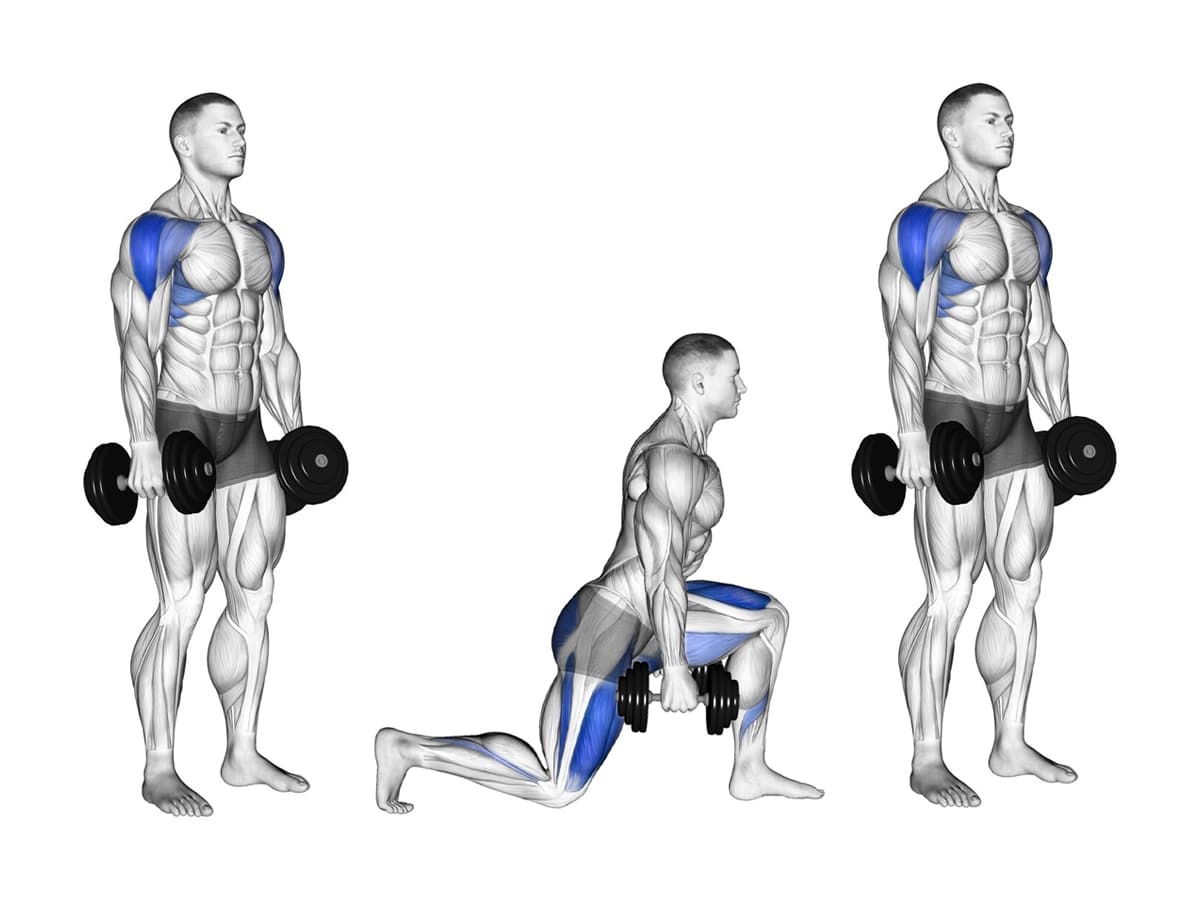
14. Walking Lunges
Walking while adding a lunge with every step seems like this glute exercise would be too easy to add to any list. But if you’re looking for a proper way to train, then the riffs of the walking lunge are myriad (as you may already know from the many in this article). Walking lunges are a simple leg-strengthening exercise that workout the quads and glutes (21). And if you’re up for a more challenging take on the lunge, employ weights, or perform the walking lunge with a medicine ball held at your midsection with both your and performing a twist with every step, which according to Healthline, is the best variation of the exercise (22).
- Stand with your feet shoulder-width apart.
- Step forward with one leg, putting the weight onto your heel.
- Bend the knee of the leg that is forward, lowering down so that it’s parallel to the floor in a lunge position.
- Pause for a split second.
- Without moving the leg that is forward, move your other foot forward, to repeat the same movement on the behind leg.
- Pause as your left leg is parallel to the floor in a lunge position.
- Repeat this movement, walking forward as you lunge, alternating legs.
Reps: 10-15
Sets: 2-3
Rest: 60 seconds between each set
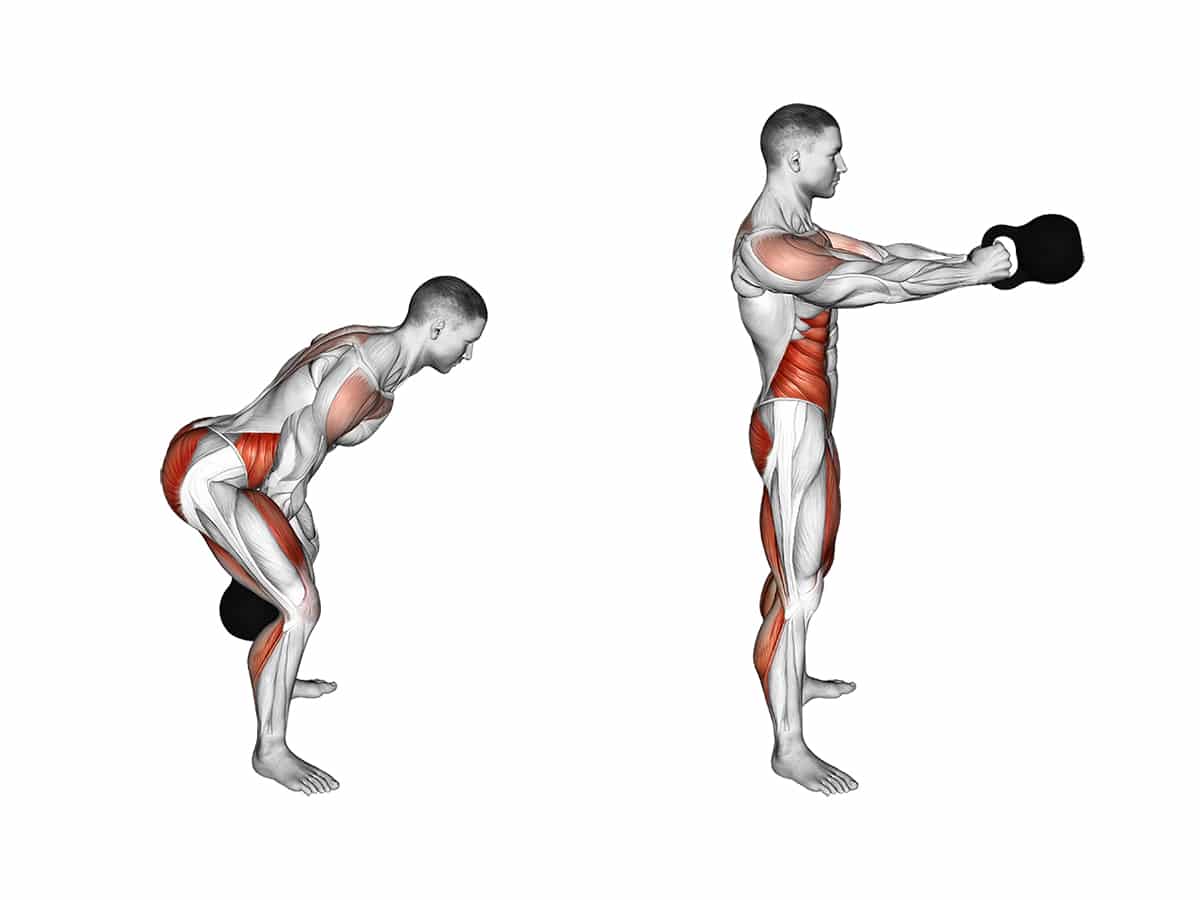
15. Kettlebell Swing
Most notably popularised by our bro, Joe Rogan, the kettlebell swing is a basic swinging exercise used to train the posterior chain (muscles that run from your neck down to your ankles: calves, hamstrings, glutes, and lower back). It involves swinging the kettlebell between the knees to eye level and can be performed either two-handed or using one hand. Practising this exercise will help reduce low back pain, enhance posture, and boost one’s athleticism.
- Stand with feet slightly wider than shoulder-width apart.
- Hold a kettlebell in front of your body with both hands and arms straight.
- While slightly bending your knees, flatten your back, hinge at your hips, and begin to swing the kettlebell back through your legs.
- Continue to build momentum while standing and swinging the kettlebell out in front of your body, up until it swings to eye level.
- Remember to engage your glutes and core as you stand up straight while pushing your hips forward.
- Once the kettlebell swings to eye-level height, your knees should be straight, and your glutes contract in a full hip extension.
Reps: 10-20
Sets: 2-3
Rest: 60 seconds between each set

16. Goblet Squat
The goblet squat is essentially a full-body exercise (23). It involves squatting while holding a single free weight — like a dumbbell or kettlebell — to one’s chest, making the exercise much easier than other squat variations, while presenting a challenge for gymgoers. Through the goblet squat, you’ll be working out your quads, hamstrings, glutes, core, forearms, and even better your jumping performance. All in all, making it the most multi-faceted glute exercise on our list.
- Stand with feet slightly wider than shoulder-width apart.
- Pick up your dumbbell upright, gripping it with both hands underneath the top of the weight and keeping it close to your chest.
- Squat down by pushing your knees to the side while moving your hips back (keep in mind that your front knee should not protrude past your toes when squatting).
- Squat back up while keeping your feet flat on the ground and the weight onto your chest.
- Complete the reps and increase the weight of the dumbbell with each set.
Reps: 6-12
Sets: 2-3
Rest: 60 seconds between each set
What are Your Glute Muscles?
For starters, let’s take a glance at the parts of the butt muscles; which isn’t much to begin with when looking at this part of the body. The glutes comprise three main muscles: the minimus, medius, and maximus. Simple. Now, in terms of function, these muscles facilitate the extension, abduction, external rotation, and internal rotation of one’s hips (as aforementioned). Of course, the glute muscles attach to many bones and the fasciae latae muscles (4), but we won’t need to get into that. Because we’re here to break it down for you (without watering down the info, of course). Ergo, to help you get your head around the important stuff without it feeling like a high school biology class, let us give you the low-down on the glute muscles and their function.
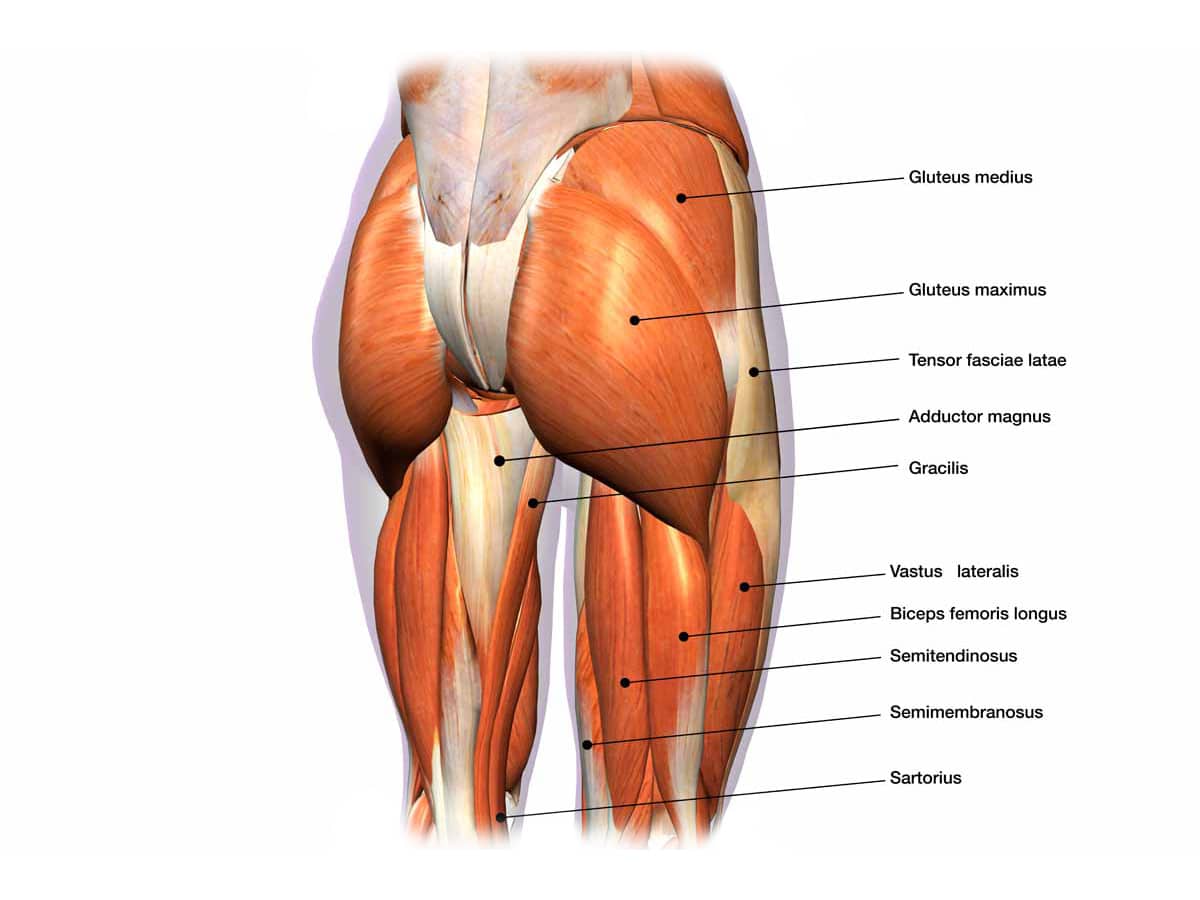
The Glute Muscle Groups
• Gluteus Minimus – The gluteus minimus is the smallest of the glute muscles (if you haven’t already noticed from its name). It has many similarities with the gluteus medius — structurally and functionally — and is positioned below the gluteus medius muscle and predominantly acts as a hip stabiliser and abductor of the hip (5).
• Gluteus Medius – The gluteus medius is the highly functional gluteal muscle that sits along the outer surface of the ilium — near the pelvis — and between the posterior and middle gluteal lines and helps with hip movement (6).
• Gluteus Maximus – The gluteus maximus is a thick muscle with a quadrangular shape. The muscle is prominent and plays a chief role in the maintenance of keeping the upper body upright. The gluteus maximus attaches to many bony compartments (7).
Things to Consider Before and After the Glutes Workouts
Warm Up – It’s a rookie mistake not to warm up before a training session. Readying your body for a workout increases your range of motion, body temperature, and activates your central nervous system (CNS), which, in turn, could curb injury and helps make the most out of your training sessions (8). To get you across how to effectively warm up, complete the following; start off with dynamic stretches, followed by a treadmill jog, then throw in some drills (like these, courtesy of Muscle & Fitness) and you’re all set for your workout (9).
Cool Down – It’s just as important to finish off a workout with a cool down as it is to start one with a warm up; trust us, it’ll save you from some soreness the next day (10). Cool downs can be done via walking, jogging, or static stretching for ten minutes post-training, and are an effective practice to promote recovery and help return your body to a pre-exercise level by decreasing your heart rate and relaxing your muscles from their tense state (11).
Rest Days – Any bodybuilder or fitness guru worth their salts will attest to rest days as being an integral part of the growth and strengthening of muscles. According to Healthline, regardless of one’s fitness level or athleticism, skipping rest days can lead to overtraining or injury (12). Meaning muscle recovery isn’t an option for anyone. But how long should your muscles rest before you can re-train them? As per The American Council on Exercise, to ensure that muscles are getting the recovery and repair they need, one must dedicate at least 72 hours of rest (as well as proper nutrition and sleep) after high-intensity workouts and at least 24 hours of rest between training sessions after low-intensity workouts (13).
Alternative Muscle Exercises and Workout & Diet Plans
If you’re hunting for more comprehensive exercise content to carve out a killer physique, then check out our body exercises section to see the insanely stacked exercise routines we have tailored for your muscles; which are served with a generous peppering of expert-backed resources, of course. Our fitness section is bursting with exercise bible plans, where you’ll also find unparalleled coverage of the best advice, tips, and the latest information on supplements, diet, and workouts that’ll help you live a healthier lifestyle. So, if longing to look and live better, it pays in spades to be ahead of the curb with the crème de la crème of body muscle exercise, health, and lifestyle content.
- 13 Best Bicep Exercises for Men
- 27 Best Oblique Exercises for Men
- 17 Best Trap Exercises for Strength & Size
- 16 Best Calf Exercises and Workouts for Men
- 10 Best Core Exercises and Workouts for Men
In case you’re keen on killing two birds with one stone, then have a look at our wealth of workout & diet plans for a more well-rounded take on fitness. These cutthroat exercise regimes and food diets were religiously followed by bodybuilders, athletes, and celebrities to optimise their health and maximise their size. So whether you’re looking for a diet to follow with the aforementioned exercise plans or seeking an all-encompassing training regime, just know you’re in good hands. Below you’ll find the latest and greatest training and dieting content to help make a positive investment in your health and physicality.
- The Rock’s Diet and Workout Plan
- Conor McGregor’s UFC Diet & Workout Plan
- John Cena’s Insane Workout and Diet Plan
- Chris Hemsworth’s Thor Diet & Workout Plan
- Chris Evans’ Captain America Workout & Diet Plan
You’ll also like:
10 Best Chest Exercises for Men
12 Best Shoulder Exercises for Men
10 Best Tricep Exercises for Men
Arnold Schwarzenegger’s Diet & Workout Plan
Glute Exercises FAQs
Barbell hip thrust, squats, and lunges are three common exercises for the glutes that can be performed with/out weights, at the gym, and in one’s home. Other popular glute exercises include the single-leg glute bridge, figureheads, lateral band walks, and the goblet squat.
In short, yes. Exercising your glutes with the detailed listicle of exercises we’ve professionally curated will bring out a bigger, better, and stronger butt.
One can train their glutes, or any muscle group, up to six days per week, respecting that it is low-intensity training. According to The American Council on Exercise, one must dedicate at least 72 hours of rest (as well as proper nutrition and sleep) after high-intensity workouts and at least 24 hours of rest between training sessions after low-intensity workouts to ensure that their muscles are getting the recovery and repair they need before re-training.
Citations
- Moore, Keith L. (2018). Clinically oriented anatomy (8th ed.). Philadelphia. pp. 722–723. ISBN 9781496347213.
- Musculoskeletal Key Hips and Thighs. (2016). Musculoskeletal Key. Available: https://musculoskeletalkey.com/hips-and-thighs/.
- Jeong, U.C., Sim, J.H., Kim, C.Y., Hwang-Bo, G., & Nam, C.W. The effects of gluteus muscle strengthening exercise and lumbar stabilization exercise on lumbar muscle strength and balance in chronic low back pain patients. Journal of physical therapy science. 2015;27(12):3813-6. Available: https://www.ncbi.nlm.nih.gov/pmc/articles/PMC4713798/.
- Trammell, A.P., Nahian, A., & Pilson, H. Anatomy, Bony Pelvis and Lower Limb, Tensor Fasciae Latae Muscle. Available: https://www.ncbi.nlm.nih.gov/books/NBK499870/.
- Greco, A.J., & Vilella, R.C. (2022) Anatomy, Bony Pelvis and Lower Limb, Gluteus Minimus Muscle. National Institute of Health. StatPearls Publishing; 2023 Jan-. Available: https://www.ncbi.nlm.nih.gov/books/NBK556144/.
- Shah, A., & Bordoni, B. (2023) Anatomy, Bony Pelvis and Lower Limb, Gluteus Medius Muscle. National Institute of Health. StatPearls Publishing; 2023 Jan-. Available: https://www.ncbi.nlm.nih.gov/books/NBK557509/.
- Elzanie, A., & Borger, J. (2022) Anatomy, Bony Pelvis and Lower Limb, Gluteus Maximus Muscle. National Institute of Health. StatPearls Publishing; 2023 Jan-. Available: https://www.ncbi.nlm.nih.gov/books/NBK538193/.
- Yeung, J.A. 9 Best Warmup Exercises For Building Mass. Muscle & Fitness. Available: https://www.muscleandfitness.com/workouts/workout-tips/9-best-warmup-exercises-maximal-mass/.
- Sachdev, P. (2021). Benefits of Warm-Up Exercises. Web MD. Available: https://www.webmd.com/fitness-exercise/benefits-of-warmup-exercises.
- Crockford, J. (2014). Five Reasons You Shouldn’t Skip Your Cool-down After Exercise. ACE: The American Council on Exercise. Available: https://www.acefitness.org/resources/everyone/blog/3683/five-reasons-you-shouldn-t-skip-your-cool-down-after-exercise/.
- Purdie, J., & Pereira, E. (2022). What Is a Cooldown? Very Well Fit. Available:
https://www.verywellfit.com/what-is-a-cool-down-3495457. - Nunez, K., & Budnis, D. (2019). Are Rest Days Important for Exercise?. Healthline. Available:
https://www.healthline.com/health/exercise-fitness/rest-day#benefits. - Mukhwana, J., & Paul, J. (2023) Muscle Recovery Time: Here’s How Long You Should Rest Between Workouts. Better Me. Available: https://betterme.world/articles/muscle-recovery-time/.
- Brazil, A., Needham, L., Palmer, J. L., & Bezodis, I. N. (2021). A comprehensive biomechanical analysis of the barbell hip thrust. PLoS ONE, 16(3). https://doi.org/10.1371/journal.pone.0249307.
- Mackey, E.R., & Riemann, B.L. (2021). Biomechanical Differences Between the Bulgarian Split-Squat and Back Squat. International Journal of Exercise Science, 14(1), 533-543. https://www.ncbi.nlm.nih.gov/pmc/articles/PMC8136570/.
- Williams, M.J., Gibson, N.V., Sorbie, G.G., Ugbolue, U.C., Brouner, J., & Easton, C. Activation of the Gluteus Maximus During Performance of the Back Squat, Split Squat, and Barbell Hip Thrust and the Relationship With Maximal Sprinting. Journal of Strength & Conditioning Research. 2021;35(1):16–24. DOI: 10.1519/JSC.0000000000002651.
- Quinn, E., & Lau, M. (2022). How to Do Weighted Step-Ups: Proper Form, Variations, and Common Mistakes. Very Well Fit. Available: https://www.verywellfit.com/weighted-step-up-exercise-3120001
- Quinn, E., & Laferrara, T. (2021). How to Do the Lateral Band Walk: Proper Form, Variations, and Common Mistakes. Very Well Fit. Available: https://www.verywellfit.com/lateral-band-walking-exercise-3120456.
- Galic, B., & Aliesha-Fetters, K. (2021). How to Do the Lateral Band Walk for Stronger Side Glutes. LiveStrong.com. Available: https://www.livestrong.com/article/13768032-lateral-band-walk/.
- Begum, J. (2021). What Is Anaerobic Exercise?. WebMD. (Accessed 20/01/2023) Available: https://www.webmd.com/fitness-exercise/what-is-anaerobic-exercise#091e9c5e82160b88-1-2.
- Williams, L., & Black, H. (2022). How to Do Walking Lunges: Proper Form, Variations, and Common Mistakes. Very Well Fit. Available: https://www.verywellfit.com/how-to-do-walking-lunges-4588048.
- Chertoff, J., & Bubnis, D. (2019). How to Step Up Your Workout with Walking Lunges. Healthline. Available: https://www.healthline.com/health/exercise-fitness/walking-lunges.
- Williams, L., & Laferrara, T. (2022). How to Do a Goblet Squat: Proper Form, Variations, and Common Mistakes. Very Well Fit. Available: https://www.verywellfit.com/how-to-goblet-squat-4589695.


